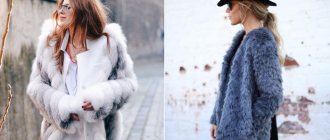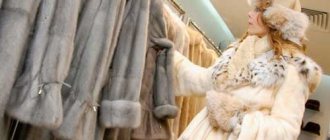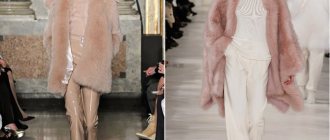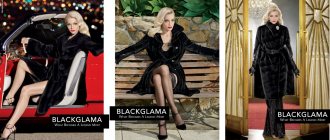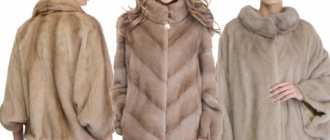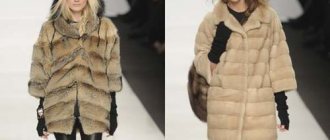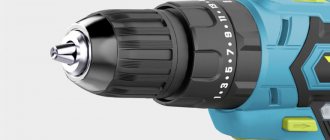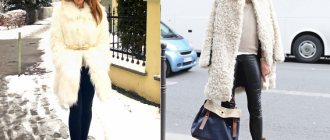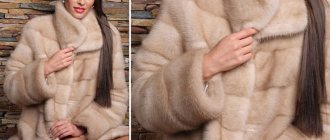If girls like the classic black version of a fur product, they will pay attention to the elegant “black diamond” model or a mink coat in a standard black color; lovers of romance and femininity will choose beige, blue or pale pink. A golden mink coat looks very rich, attractive and original. Unfortunately, you will not find golden mink anywhere in nature. Breeders were unable to obtain fur of this shade. A gold-colored mink coat can be obtained by lightening natural dark fur. Bleach is applied to the skin to lighten the pile. The whole process requires quite painstaking and careful work, otherwise the presentation of stylish outerwear will be ruined.
Mink is popular
One of the most popular types of fur for many years is, of course, mink! It was from this fur that every woman dreamed of having a fur coat at least once in her life. A mink coat is, first of all, a sign of a business woman, a sign of style and wealth. Today there are a huge number of types of mink. They were mainly bred from two main species: European and American mink. One of the advantages of this fur is its amazing practicality. A mink coat can last more than 20 years if treated properly. In terms of practicality, mink is equal to sable. Mink fur is so popular that it never gets boring. The ability to change the texture and color of mink is limitless. It was her natural beauty that captivated the designers. Today, white, brown, black, blue mink triumphantly walks down the catwalk, deservedly in the forefront among the most stylish, modern and exclusive materials in the fashion industry.
Features of golden fur coats
Canadian mink golden sand looks gorgeous. This is a natural color, you can hardly find it anywhere. It differs from other styles in its velvety and smooth pile, as well as an attractive color scheme. It will undoubtedly be a decoration in your collection.
If you decide to buy a mink coat in Gold color, then do not forget that it requires special care and respect. New clothes should not be exposed to sunlight, as they may fade. It is better to wear a warm down jacket, jacket or coat in sunny weather. Traces of road dirt and various types of stains can quickly appear on clothing, and it will be very difficult to remove them. It is recommended to store the luxury attribute in a spacious, dark closet or a special refrigerator. Make a purchase of fur outerwear only in a specialized store. Then the fur coat will serve you for many years and will keep you warm in more than one harsh winter.
European mink
This is a predatory mammal from the mustelidae family. Despite the fact that the European mink is similar to the American mink, in fact they are distant relatives. Subspecies - Caucasian European mink - locality Nizhny Novgorod, Caucasus, Lower Don region. Lives in small rivers and streams, prefers to feed on amphibians, fish, and insects. The Caucasian European mink is listed in the Red Book of Russia. Externally, the mink is typical of small mustelids, with a large head, somewhat flattened, short ears, almost hidden in the fur. The mink feels great near water, this is explained by the peculiarity of the structure of the fur, which protects the animal from moisture. Not so long ago, the location of the European mink was widespread throughout almost the entire European part of Russia. Recently, this species of mink has declined significantly, which is attributed to the influence of hydroelectric power stations and associated reservoirs. European mink is a valuable fur-bearing animal!
American mink
It is very similar to the European mink. The American mink is slightly larger and has a slightly longer tail than the European mink. It has a long slender body with short legs, the fur is soft and shiny, the color is almost the same as that of the European mink (brown or black). American mink is more expensive than European mink. It has long been one of the main commercial species in North America. However, today the main source of fur is mink farms. Today, the natural color of American mink ranges from white to black, brown and gray-blue tones. American mink is not only beautiful, but also highly practical. Lately, designers have been constantly showing a lot of mink fur products, which contributes to the emergence of new shades. It was the American mink that became the progenitor of all farmed mink in the world.
Dyed mink
- Anthracite . The guard hair is dyed black, and the underfur is dyed brown. It turns out something similar to scanblack
- Palette of dark colors (from green to red) . Obtained by dyeing the guard hair and underfur, and bleaching the skin side
- Palette of bright colors . It is obtained using the same technology as dark ones, but the inner side is bleached, not the skin side
- Briza . Painting neon colors with fluorescent paint
- Blue-gray colors . The entire fur is dyed blue-gray, and the flesh is bleached
- Snow top . Bleaching or dyeing of guard hair with its reservation. During the process, a smooth transition is obtained from light to dark or vice versa
- Milky Way . The painting process is very similar to the previous version. Only the bright areas are unevenly distributed. This results in a starry sky effect.
- Degrade . Heterogeneous dyeing of the skin with a flow from head to tail
- Bear . Chocolate color, tinted, with a black stripe along the ridge
The above list of mink colors is not exhaustive; it describes only the most common colors that are used when sewing fur hats and outerwear.
Russian mink
One of the mink varieties. In 1928, the Russian mink was bred in Russia based on the introduced wild North American mink. During the time the mink was bred in Russia, it acquired certain differences from its ancestor - tall hair and thick, tall underfur. It is because of these signs that Russian mink fur is not afraid of moisture and is really very warm, shiny, and silky. This particular mink is most popular among manufacturers of Russian fur products. It is used both in the manufacture of accessories, decoration, and in the production of large products - fur coats, coats, hats, capes. Mink raised in Russia is a standard brown breed that varies from brown to dark black.
Scandinavian mink
One of the varieties of American mink, brought to Northern Europe in the 20th century. Mink breeding has become an important economic sector for Finland and Denmark, thanks to the active work of Scandinavian fur farmers. The Scandinavian mink is the most widespread on the planet. Distinctive features of this fur from others are an even awn of medium height and a thick underfur. For Russian furriers, Scandinavian mink is a favorite material. This fur is ideal for the Russian climate. Scandinavian mink of the highest quality is much cheaper than its American counterpart. A popular type of Scandinavian mink is “Scanblack” fur. He has proven himself all over the world. It is also called “black diamond”. One of the important advantages of Scandinavian mink is that it holds its shape perfectly, its color is uniform and without visible differences. Fashionistas from Russia prefer coats made of Scandinavian mink, since this particular fur has a clear silhouette, neat shoulder line and collar. Products made from this fur are characterized by: glamorous shimmer, respectable color, luxury.
Bleached mink
- Gold (gold) . Artificially bleached brown mink skins from Denmark, Finland and Sweden. The final shade of gold depends on the initial tone of the brown mink
- Crushed ice . Mink with a silver-blue tint, the underfur of which is completely bleached. It is obtained by lightening sapphire-colored skins
- Champagne. Mink with a golden-cognac tint, the underfur of which is also bleached. The original mink is the color sergo (gray-blue)
Finnish mink
One of the varieties of Scandinavian mink, bred in Northern Europe. Finnish mink fur is extremely popular among both manufacturers and buyers. Varieties of Finnish wild mink tones are popular in fur markets. The darker ones are called “skanbrown”, the light colors are called “scanglow”, another group of mink is the blue “violet”. The most common today are the various tones of wild-type Finnish mink (beige group). Among them, the darker ones are called “scanbrown”, the light colors are called “scanglow”. The grey-brown, light tone of Finnish mink is called “pastel”. Another group of mink is blue: “sapphire”, “violet”, etc. North American mink. This fur is bred on fur farms in the USA and Canada. Dense and high down, the hairline of the skins has a low axis. This type of fur feels like velvet to the touch. This particular fur is considered exclusive, since the breeding rate of North American mink is not high, and the quality of the fur is high. American mink is called BLACKGLAMA, Scandinavian mink is called BLACK NAFA. The BLACKGLAMA mark is assigned to a small number of mink produced. The difference between BLACKGLAMA and Scandinavian and Russian mink is the length of the guard hair. The BLACKGLAMA brand is very popular today and is often counterfeited. One of the features of North American minks is that skins coming from different continents can differ significantly from each other, since climatic conditions, feeding, and maintenance have a great influence. In this regard, mink from different batches cannot be used in one product.
Mink scanblack (Scandinavian black) . is a mink with a light brown tint and has a very pleasant texture to the touch. One of the significant advantages of these skins is that they hold their shape perfectly, which allows fashion designers to make a wide variety of models from this fur. Products made from this white fur are cheaper and more accessible, this is due to the fact that the cost of “scanblack” is inferior to its main competitor - black mink “blackgamma”. STK mink (standard dark brown) is a mink produced in Russia, naturally dark brown in color. Russian mink is quite affordable. In terms of aesthetic properties, this fur is not inferior to American and Scandinavian mink. Its color is so rich that it resembles the color of dark chocolate, its fur is fluffy and resistant to high humidity. Mink “Gold” (gold) is a brown color, not given by nature, but acquired through bleaching using technology. In this connection, a palette of various shades is obtained: from “white gold” to the color of copper and slightly greenish bronze. This fur is produced from a Scandinavian variety of mink and is quite popular among manufacturers and buyers. Sapphire mink (blue) is the most popular mink color. This Scandinavian mink is a soft blue-gray shade. This fur is chosen by those women who strive to create the image of a radiant, cold beauty. Like other types of mink, this fur has good wear resistance and moisture resistance. There are many different color mutations available on the world market. With the development of computer technology, digital dyeing was developed, with the help of which various patterns are applied to mink fur, thereby giving this fur beauty, exclusivity, and style.
MINK COLORS
The natural palette of raised
mink
includes a wide range of various colors and shades: from white, pearl, pastel colors, palomino (champagne) and gold (gold) shades to various blue-gray, silver, sapphire, dark brown tones and black.
The most common mink color
– natural brown and its various shades, which make up more than half of all color variations
of fur
.
The most expensive type of American mink is blackglama
, it has a rich black and deep color, tinged with brown.
The peculiarity of this fur
is the very short guard hair: the underfur almost rises above the guard, which gives
blackglama mink fur
a plucked effect and a unique velvety feel.
One of the main advantages of mink fur is
in addition to its external beauty, it is highly practical and wear-resistant.
If mink
skins are properly tanned and
the fur product made
from them is properly stored, then
a mink fur coat
can last 20 years.
With intensive wear of a mink coat,
this period is reduced to 14 years, but it is still very long.
In terms of wear resistance , mink
is equivalent to 70% of the standard
otter fur
(
the otter
has a wear resistance of 100%).
sable fur
has the same percentage of the standard .
Recently mink fur
actively used in both high and mass fashion.
Interest in mink
as a material for making
fur clothing
and
fur accessories
is constantly growing.
Regularly appearing new shades of mink fur
natural that are improving every year ,
give fashion designers unlimited opportunity for imagination.
White, black, brown and blue mink
take a well-deserved place on the catwalks of Europe, America and Asia.
mink
breeding industry is based on the same American species.
Over the years of work by breeders, the properties of mink fur
have become different, depending on the place of breeding.
Thus, several types of mink
, for example, Scandinavian, Russian, Canadian, etc.
Mink "scanblack "
«Scanblack»
— “Scandinavian black” is the name of the natural color of black
Scandinavian mink
, which has a very high reputation among manufacturers and buyers
of fur products
.
Like any natural black fur
, “scanblack” actually has a slight brownish tint.
It will be noticeable if you compare it with dyed and tinted black furs
.
Thanks to the even, clear direction of the guard hair and its short length,
scanblack
mink And for its special shine and shimmer under the rays of light, this fur
is sometimes called “
black diamond
”.
The skins of this type of mink
have one significant advantage: they hold their shape perfectly, which allows the furrier to make
fur products
scanblack mink .
The fabric made from this fur
is smooth, without visible seams, changes in pile or any difference in color.
Black
Scandinavian mink fur
coats typically have neat shoulder lines and a well-defined collar.
In addition, the cost of
scanblack
mink mink
, so
products made from this fur
are not so expensive.
Mink STK
STK –
“standard dark brown”
is a Russian mink
of natural dark brown color, which is most popular in the domestic
fur
.
This type of mink
has become a bestseller not only because of the fashion for dark
mink
, but also because of the relatively low
price of the skins
.
In terms of aesthetic properties, STK mink
is practically not inferior to the best examples
of Scandinavian
and
American mink
.
Its rich brown color resembles the color of dark chocolate, and leaves a feeling of warmth and comfort. Quite long guard hair and thick underfur make this fur
very fluffy and create a light shaggy effect, which looks very impressive in
fur products
.
In addition, STK mink
, like other
Russian mink
, is very resistant to high humidity.
Thanks to this, fur products
made from it wear very well in the Russian climate.
Mink "gold "
"Gold" - "Gold" -
mink
tone , which is not natural.
It is obtained in modern production conditions by bleaching fur
.
The technology for obtaining this type of mink
is similar to hair lightening.
And the darker the initial color of the mink fur
, the darker the final shade of “golden” will be.
Thus, we get a palette of a wide variety of shades: from very light brass and “white gold”, to copper, red and slightly greenish bronze. At the same time, the color mink
fur retains the transition from a lighter shade of the side to a darker color of the ridge, which leaves a feeling of “natural”
fur
.
Gold
mink of mink
and is quite popular among
fur clothing
and buyers.
It leaves its owners with the impression of real “ soft gold
”.
Mink "mahogany" ( mahogany)
"Mahogany" or "mahogany"
– the classic natural color
of mink
is a very dark and rich brown shade, quite close to the natural color
of mink
in nature.
The mahogany
color was created by crossing
black mink with minks
of other colors to
the fur
its dark shade and an even darker stripe along the ridge.
However, today on sale you can see mahogany mink
not only of the “classic” shade, but also of a lighter, even reddish tone.
This color is one of the most common in both American and Scandinavian mink
.
At the same time, “ mahogany
” is valued on the market somewhat higher than other dark brown
shades of mink
(for example, the same
“scanglow” mink
).
And it is the mahogany mink fur coat
that is considered a classic
fur product
.
Mahogany minks
are characterized by very thick guard hairs, which are short in height and inherited from
the black mink
.
In addition, these minks
have a very soft deep underfur, which gives
the fur
special qualities.
Mink "walnut"
“Nut” is one of the “folk” names for Scandinavian mink
natural brown shade.
This fur
almost exactly reproduces the original natural color
of mink skin
- medium brown, with a darker ridge.
Since “walnut” is a very calm fur
, it is great for women of all types of appearance.
fur products
from
walnut mink
, craftsmen strive to preserve the “game” of the lighter sides and darker ridges of these
skins
.
Thanks to this, a walnut mink coat
acquires an interesting iridescent color and emphasizes the slimness of its owner.
Mink "scanglow "
"Scanglow" -
the name of
the Finnish mink
of a light brown tone.
The fur
of this
mink
has a pleasant shade of hot chocolate - lighter on the sides and much darker towards the ridge.
Scanglow mink
is extremely valuable among
fur
.
About 20% of all mink fur
sold at the Finnish
Sales
is
Scanglow mink
.
To determine the quality of a Scanglow mink,
it is very important to pay attention to the color of the underfur.
If it is too light a gray shade, the mink
is considered defective and is sold at a lower price.
Mink "sapphire "
"Sapphire"
- blue is one of the most popular
mink tones
, which belongs to the group of gray-blue colors.
This is a Scandinavian mink
of a delicate gray-blue hue, with a clearly defined darker ridge line.
Thanks to this “double” color, sapphire mink
is often sewn into fabrics with a clear vertical pattern: alternating light and dark stripes.
Mink “Sapphire”
is the choice of those women who strive to create an image of radiant, cold beauty.
Sapphire mink
is considered one of the classic colors for
fur coats
, as well as a variety of
mink fur accessories
.
Like other types of mink
, it has excellent wear resistance and moisture resistance.
Mink "violet "
"Violet" -
a rarer mutation
“sapphire”
mink , which has a light gray tint.
In contrast to the original “sapphire” tone, the skins
of this
mink
have a less noticeable transition from light sides to a dark ridge.
Otherwise, the “violet” mink
fits into the general description of the characteristics of
the Finnish mink:
a fairly long spine and thick underfur gives this
fur
a special sophistication and beauty.
From the point of view of the design of fur clothing
, the “violet” mink
has one feature:
a coat made of this fur
will not suit every woman’s face.
The problem is that the light gray-blue shade “violet” is too “pale”, so sometimes the owner of such a fur coat
can get lost in such
fur
.
Therefore, this type of mink
is not very often found on the streets of Russian cities.
White mink ( white)
White mink
, has become very popular in recent years and is literally at the very peak
of fur fashion
.
Every collection of fur products
necessarily contains several models made exclusively from this
snow-white fur
.
Unlike many other shades of mink
,
white mink
does not have a color transition from lighter to darker: it is
a skin of
an equally even white tone, which allows you to create canvases of a single color.
The imagination of fur
is not limited to the simple use
of white mink
.
It is combined with a variety of modern methods of fur
: perforation,
laser cutting
, in which
the fur
is burned so that patterns of hair of different heights are formed on it, with the effect of “natural paws”.
Unfortunately, in Russia, products made from white mink
are still quite rare and are rather an exception.
Much more common are darker shades of mink
(no longer snow-white, but rather beige) - light beige “pearl” and gray-beige “topaz” (“palomino”).
Cross mink ( cross)
The constant work of breeders leads to the fact that a large number of different color mutations of mink
.
One of the most popular today is the hybrid “cross” mink “black cross”
.
The natural color of this mink
is a combination of very black and snow-white colors.
At the same time, the black one, running along the ridge, in the area of the “shoulders” of the skin
forms a pronounced cross on a white background.
You can find
other beautiful versions
of cross mink
fur auctions - blue (“sapphire cross”), pastel (“pastel cross”), or
gray mink
with silver cross markings (“silver cross”).
But such lots of fur
quite rarely, and are much more expensive.
Mink “jaguar”
“
Jaguar” –
An extremely interesting type of
hybrid mink,
reminiscent in color of traditional cow skin.
Such a mink
has a bright white base
color of the skin
, over which black spots of uneven shape are scattered.
Since this color is the result of selection and not dyeing, Jaguar mink
does not lose the properties inherent in
natural fur
: it has high wear resistance and a very beautiful color, which becomes more golden under the rays of the sun.
This makes the black spots appear even brighter on the skins
.
Craftsmen make a wide variety of
fur products
from Jaguar mink .
Including original fur coats
,
short fur coats
and
fur jackets
.
Unlike pure white mink
,
jaguar mink,
due to its coloring, creates a very picturesque spotted canvas that does not require additional decoration.
Mink “star dust” ( stardust)
“Stardust” is a very rare mutation of the Scandinavian mink
.
This is a gray mink
with tiny white patches of awns.
The lot sizes in which this fur
appears at auctions can be limited to literally hundreds
of skins
.
If we consider that the average size of mink skin
used for the manufacture
of fur products
is usually a square of 15x15 cm, then from the entire batch of
“stardust”
mink fur coats
.
This circumstance makes “stardust” a very expensive fur
belonging to the premium class.
Some other batches of hybrid mink
.
"Marble" mink
(marble)
"Marble" mink
- probably the only option when the yellow tint of
mink
fur is obtained not by bleaching, but as a result of mutation.
This is a unique hybrid mink
that has a dark yellow color with chocolate streaks.
Like some other hybrid mink
, “marble” is produced in very small batches, so it is expensive and especially valued among furriers.
Dyed mink
Despite the fact that fur farmers around the world work every day to increase the number and variety of mink colors,
masters engaged in
fur
constantly experiment with
fur
, dyeing it in different colors.
Most often,
traditional immersion dyeing and tinting are used
color mink They are especially often used when it is necessary to obtain
an imitation of a more expensive dark brown
mink
mink .
Thus, some manufacturers of fur coats
and other
fur products
may even mislead their customers by presenting
dyed mink
as a more
valuable type of fur
.
There are other, more complex technologies for multi-layer dyeing of mink fur
.
For example, mink
can be dyed with the top of the spine reserved, and then
the effect of the so-called “snow-top” is obtained
the skin Minks
of close to wild colors are very often bleached, creating a variety of shades of “golden”
mink.
In addition, various methods are often used to enhance the color of the
mink
in order to highlight them against the background of the lighter side part
of the skin
.
of screen-dying mink became a real hit.
.
Then mink
skins were painted to look like leopard, tiger, zebra, giraffe and other tropical animals.
Today, with the help of computer dyeing (it is called digital),
any multi-colored patterns can be applied
mink The wide range of possibilities that mink dyeing technology
allows for even wider use of this
fur
.
After all, today mink
is the only
fur
from which you can sew a single fabric, similar to fabric, and use it not only for making
fur clothing
, but also in the interior.
However, when buying a fur coat
from dyed
mink
, it must be taken into account that exposure to the chemicals contained in the dyes somewhat changes
the properties of the fur
.
On average, a dyed mink
can serve its owner 4-5 years less than
a mink
of natural colors.
determine whether a mink
dyed by the color of the back side of its
skin
- the flesh.
If the color of the mink
is natural, then the flesh remains white, but if it is painted, then
the flesh
will be colored.
Return to articles
